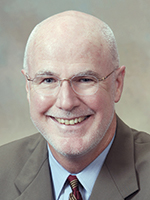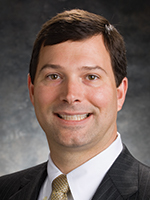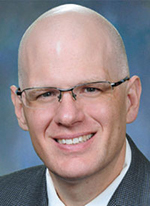Anne Paxton
October 2017—Until recently, new treatments for stage 4 lung cancer have generally required weighing toxicity against hopes that patients’ average length of survival might be extended by a month or two. But “our expectations are increasing as therapies have improved,” says Geoff Oxnard, MD, thoracic oncologist at Dana-Farber Cancer Institute and assistant professor of medicine at Harvard Medical School. “Patients and doctors are increasingly expecting targeted therapies with dramatic effect and few side effects.”
Amid this transition, liquid biopsy is making big-time waves in cancer treatment. Though its uptake may not be consistent throughout the U.S., and test ordering patterns may be obscured by the tests that are direct send-outs from oncologists to commercial laboratories, there is little doubt that liquid biopsy is swiftly winning fans in oncology.
“Liquid biopsy is a diagnostic test that has really swept oncology,” in the same way that PET scans and genotyping did, Dr. Oxnard says.
He led an influential prospective trial, published in 2016, that demonstrated liquid biopsy’s ability to detect key mutations in three days compared with 12 to 27 days for tissue genotyping (Sacher AG, et al. JAMA Oncol. 2016;2[8]:1014–1022). “Liquid biopsy is a reality in oncology today. It’s amazing how rapidly it has become the standard of care. And I think pathology labs everywhere are trying to adapt to it and make themselves ready for this new reality.”
Under the guidelines of the National Comprehensive Cancer Network, EGFR mutation testing is recommended in patients with advanced non-small cell lung cancer. NSCLC patients who have EGFR exon 19 deletions or L858R mutations are candidates for the EGFR-targeted therapy Tarceva (erlotinib) in first-line treatment, and patients with the resistance mutation T790M are candidates for Tagrisso (osimertinib) in subsequent lines of treatment.

Dr. Oxnard
Roche Diagnostics’ Cobas EGFR Mutation Test v2 is so far the only liquid biopsy test that is FDA approved for clinical use. Benjamin Levy, MD, clinical director of medical oncology and medical director of thoracic oncology for the Johns Hopkins Sidney Kimmel Comprehensive Cancer Center at Sibley Memorial Hospital, points out that the Roche test was used in a pivotal trial for AstraZeneca’s Tagrisso, and was approved by the FDA as the companion diagnostic, but that many other commercially available assays are able to perform at the same level.
Plasma-based next-generation sequencing platforms can identify roughly 75 somatic alterations in the blood, Dr. Levy says. Several trials have evaluated these platforms in advanced cancer patients and found a fairly high concordance with matched tissue, he says. “This suggests that a plasma test may be an accurate molecular surrogate of tumor biology. While these assays have high specificity,” he says, “the clinical sensitivity is oftentimes contingent on degree of metastatic burden—the more metastatic sites of disease, the more likely you are to find relevant alterations in the blood.” One of the real advantages of plasma testing, he notes, is its turnaround time compared with tissue: “It can take anywhere from two to four weeks to perform genetic interrogation on tissue, where some of the liquid platforms have turnaround times in the five- to 10-day range.”
The current role for liquid biopsies is to identify resistant mutations for patients on targeted therapies, specifically EGFR-directed TKIs. But there may be additional clinical situations in which liquid biopsies can add value, Dr. Levy says, citing treatment-naïve patients. In Dr. Levy’s clinical practice treating lung cancer, patients with an inconclusive biopsy in which a lung cancer diagnosis is made may not have enough tissue for molecular testing. “Sometimes there just is not enough specimen to discover the genetic alterations underpinning the tumor. That’s when liquid biopsies may come into play—if a rebiopsy is not feasible or if we want answers quickly.”
There are at least two possible future uses of plasma genotyping, he says. One is looking at the dynamic changes in a particular mutation over time to see if the changes are predictive of how a patient is going to do in the long run. The second is studying patients who are cured by surgery, chemotherapy, or radiation. “Unfortunately, for those patients the only modality we currently have in detecting recurrences is CT scans. And some recent data from France suggest that CT scans may not improve survival for lung cancer patients.” While Dr. Levy still uses CT scans to detect recurrent disease in patients who are cured, evaluating ctDNA to assess micrometastatic disease offers promise, he says, and may represent a new diagnostic niche for these platforms.
About two years ago, Paul R. Walker, MD, chief of the Division of Hematology/Oncology at Brody School of Medicine, East Carolina University, Greenville, NC, started using the Biodesix digital liquid biopsy test GeneStrat in his daily practice diagnosing and treating patients with NSCLC. Given the assay’s validation and high specificity, “it’s one of those things where you use something new and you start seeing things you never saw before. Squamous cells, for example, are not supposed to have EGFR mutations, yet you start seeing those things and making decisions based on them because you know the test is validated.”
While only Roche’s Cobas test is an FDA-approved diagnostic, the regulatory status of the many commercial tests available is evolving, Dr. Walker says. “GeneStrat is covered by Medicare, and we have a partnership with Biodesix, which is marketing GeneStrat to put everyone on a study, so if their insurance doesn’t cover it, there is no or very low out-of-pocket cost for the individual.”

Dr. Walker
While NGS, which can take 10 to 14 days, is a nice option, Dr. Walker says, “it gives you so much information that you’re not going to act upon. With even a negative GeneStrat, where you have excluded EGFR or ALK as reliably as with tissue, you can immediately step to chemotherapy and immune therapy, which can double the response rate compared to chemo alone or immune therapy alone. In nonsquamous lung cancer, you can start out with the best treatment within three days; you don’t need to keep ordering tests. So the liquid biopsy has radically changed the timing and outcome of the treatment decision.”
In one recent case at his institution, for example, a patient had had six months of recurring pneumonias, but because she was a female and a minimal smoker, nobody had ordered a simple chest x-ray. “When we got the biopsy, it was adenocarcinoma, and we got the GeneStrat and found no EGFR or ALK fusion. We started chemo and immune therapy, and literally within seven days she was feeling the best she had in six months. With standard chemotherapy she would have struggled and struggled.”
“We know that 60 percent of patients with ALK fusion will have brain metastases,” Dr. Walker points out. “So for anybody with lung cancer and brain metastasis, you can get a liquid biopsy and if there’s an ALK fusion you can start on second-generation ALK inhibitor. And that will have a response rate within the brain of 80 percent-plus, and 40 percent complete response, so those patients don’t need brain radiation therapy.” A study of solid tumors presented at the ASCO meeting this year showed that in a quarter of such patients, there was a seven- to eight-month survival benefit by starting early, he adds.
“If it turns out that the patient has an actual mutation that is druggable and you don’t know that or don’t treat that, the median survival drops 18 months. So you can’t just say, ‘We didn’t have enough tissue to test for it; therefore we’re not.’” His department expects to have results soon on an internal study comparing those who have had a GeneStrat test with a cohort of similar patients to evaluate the impact of treatment start time.
Dr. Walker believes there must be a greater educational focus to get clinicians to understand that liquid biopsy has been validated in repeated studies and that negative tests as well as positive tests have therapeutic impact.
“I think the lack of that education is playing a role in the slow adoption of oncologists using liquid biopsy.” In a 2016 survey of oncologists, the clinicians reported using liquid biopsy on about 25 percent of their patients, but Dr. Walker suspects the number in eastern North Carolina to be more like 10 percent, at least in the lung cancer world where he works. “Every regional medical oncologist I talk to, they’ve not used it before.”
A guidelines mentality is playing a role, in his view. “Medical oncologists now hide behind guidelines and say, ‘If I’m following the guidelines, I’m providing the best care.’ And ‘If I’m thinking differently from the guidelines, then I must be wrong.’ Everybody wants to have medicolegal protection, but only six percent of the guidelines are truly evidence based, and you’re never going to get full studies to answer all the decision nuances you have to make.”
Citing cost as a form of cover for opting against a diagnostic or a treatment can have ironies. “It’s sort of an interesting thing to see someone who says immediately, ‘I don’t do a test because of the cost.’ Well, what do you mean? You would give the wrong chemotherapy for $10,000 a month? What about that cost?” Dr. Walker says. From experience, he suspects that the pharmaceutical industry, with few regulations on price, will price out treatment with immune checkpoint inhibitors at $12,000 to $16,000 a month. “And I think, to be honest, the cost of the test is likely to be the cost of one cycle of chemotherapy.
“It should be far less, but if you’re avoiding the wrong chemotherapy, then from a cost-value standpoint, a test like a liquid biopsy or NGS, when you can get the right therapy from the beginning and improved outcomes—and we’re not talking 1.6 months; we’re talking 18 months and possibly the ability to live several years without having full brain radiation therapy—that becomes priceless in the sense that you get every metric of a better patient outcome.”
Does tissue biopsy have a future? “Plasma and tissue biopsies are complementary, not mutually exclusive, so ultimately they are both going to continue to be important,” Dr. Walker says.
Liquid biopsy gives oncologists the potential to create many more options for patients, says Dana-Farber’s Dr. Oxnard. As a result, he is noticing that its uses are expanding. Although the FDA approval is for use in lung cancer to detect the EGFR mutation, “now that we have launched an assay for clinical use, we’re finding doctors are starting to use liquid biopsy in ways that were not expected originally.”
It’s a pattern that’s anecdotal and not easy to quantify, he says. They are ordering the test within the expected clinical setting to detect a targetable EGFR mutation and T790M mutations in resistant patients. But they are also using liquid biopsy to help clarify whether a lung cancer has recurred after surgery, to detect resistance to a next-generation TKI like osimertinib, to gauge the aggressiveness of a cancer, or to retest resistance when an initial blood test is negative if it becomes positive over time.
As with all therapeutics, Dr. Oxnard says, “First there is use within the expected confines, then doctors start to push the edges a bit and find other ways of using an assay, and that’s the leading edge of diagnostic development. That’s where the data needs to start catching up. We need better data that clarifies—for example, if liquid biopsies are used as a response monitoring assay—what our turnaround time would need to be, and what kind of quantification is needed to use this approach in more unexpected ways.”
The three broad types of cfDNA genotyping assays are allele-specific PCR, like the Roche Cobas EGFR v2 test; digital PCR, such as the assays by Sysmex and Biodesix; and NGS assays, which include Guardant Health’s Guardant360 and others.
He and colleagues developed their own digital droplet PCR-based assay that detects EGFR and KRAS mutations in NSCLC patients, and other molecular diagnostics labs can offer their own assays as well. “You don’t need commercial diagnostics companies to offer this for you. PCR is a terrific platform and very, very scalable.” This capability does require technical experience, but “it actually makes personalized precision oncology widely scaled and available anywhere.”
And the dramatically shorter turnaround time of liquid biopsy is opening up targeted therapies to many more patients. For example, a recent patient of his, a nonsmoker with advanced lung cancer, was ill with brain metastases and hospitalized. “A patient like that would historically go in hospice. But with a blood test for EGFR that takes a matter of days, we can now get the patient on targeted therapy and turn things around. It’s still lung cancer. It’s still devastating. But the threshold to be able to offer precision medicine becomes much lower.”
Liquid biopsy does have major limitations, he cautions. “We need to acknowledge it’s not perfect technology. Only about 80 percent of advanced lung cancer patients shed DNA into the blood, so liquid biopsy does not fully replace tissue biopsy and it does not replace the diagnosis of lung cancer. If I send a blood test to find a KRAS mutation, I still don’t know what kind of cancer you have.”
Clinicians don’t always recognize the limitations. “Let’s say an EGFR patient diagnosed with cancer responds to therapy, they develop resistance, and the test shows no mutation. An uninformed clinician might say, ‘Wow, the EGFR mutation is gone. I guess I should stop EGFR therapy.’ But the mutation is still there. It’s just not being shed into the DNA, and the assay is not sensitive enough to detect it.”
But getting liquid biopsy results in 30 minutes is not out of the question with the next generation of platforms, which Dr. Oxnard expects will have digital PCR assays that are even faster, cheaper, easier, and more automated. “How can we make a liquid biopsy as fast as oncology decision-making? That’s the next task,” he says. The research potential is exciting as well: “Blood is cheap to collect. If liquid biopsy were made a routine part of clinical trials, we could collect serial plasma to look at patients’ response, to look at resistance, to look at all sorts of things.”
Liquid biopsy is such a compelling specimen and clinical approach, Dr. Oxnard says, that any pathologist needs to be able to answer the question from an oncologist or other clinician about what their institution is offering. “What is our institution doing to be ready to offer liquid biopsy to our patients? We need to be proactive in terms of simplifying billing, reimbursement, ordering, and handling. Because just a year ago, for us to order one of these send-outs was an incredibly complicated process with a special order, a special signoff. We can’t make this hard.” As cancer centers and as laboratories, he adds, “we need to be active in integrating it into our offerings.”
As one of the launch partners for Roche’s Cobas test, Carolinas HealthCare System was ready to use the plasma-based test on day one after its FDA approval on June 1 of last year, says John Longshore, PhD, director of molecular pathology. “We had been using the tissue side of the test for many years, so we just added the plasma-based test as a second sample type.”
It’s been a game changer, Dr. Longshore says. “It’s difficult for many patients to undergo a tissue biopsy, and there can be long delays waiting for an appointment to have one, whereas everyone has a great phlebotomist. And the collection can be done with an EDTA vacutainer. So it’s opened up our ability to test in the community setting.” Although tissue is still the main sample type, making up 80 percent of the laboratory’s biopsies, plasma is gaining traction, he says, and clinicians have migrated toward using it in challenging clinical situations.
The clinicians will typically order a cell-free DNA EGFR test and tissue biopsy at the same time. “The plasma result comes back very quickly, and if it’s positive the clinician can stop and change therapy for the patient. If it’s negative, we already have the biopsy scheduled.”

Dr. Longshore
He agrees there seems to have been a slow uptake of liquid biopsy, but notes that given the direct-to-oncologist marketing of panel-based tests like GeneStrat or Guardant360, he isn’t getting the whole picture. “I’m sure my oncologists are ordering more plasma testing. It doesn’t come to pathology, so I’m not aware of those orders.” In such cases, he adds, it can be challenging for hospital-based pathologists to be part of a multidisciplinary patient management approach.
Initial concerns that the plasma test was relatively insensitive compared with tissue have faded. “When we have taken samples and performed next-generation sequencing in parallel with the Cobas EGFR plasma test, the results correlate about 92 percent of the time. That tells me it’s not really an issue with the technology that is used, but more the fact that only two-thirds of patients shed circulating DNA into their peripheral circulation.”
Preanalytical issues can arise, Dr. Longshore notes. “Obviously the circulating DNA fragments are very small and quite labile, so we want to try to separate the plasma from the remaining blood components within four hours after collection to prevent degradation of the ctDNA. The ability to have a tube to preserve ctDNA and not have to perform separation immediately certainly would be of benefit,” he says. A workaround might be to use preservative tubes such as Ariosa tubes, although those would be off-label uses. At some remote settings, the plasma may have to be separated from the remaining blood components before refrigeration or frozen shipment to a biomarker lab, which can be a cumbersome process in a medical office or small hospital.
Clinicians may need further education on the caveats needed to understand positive and negative plasma test results, Dr. Longshore says, and he hopes the clinical guideline that the CAP, AMP, and IASLC are finalizing, on the selection of lung cancer patients for treatment with TKI, will help clinicians and pathologists deal with the diagnostic dilemmas, how to triage patients with a negative result, how to back up results with a second biopsy, and so on.
“When you understand the good and bad side of both tissue- and plasma-based techniques, and how they complement each other, if you can find a way to use them in the appropriate settings and in the correct order, together they can be quite powerful,” he says.
Clinicians may also need guidance on appropriate ordering. Now that the clinical implementation of a laboratory-developed EGFR ctDNA test has been running for more than a year at Brigham and Women’s Hospital, “we’ve found that clinicians will often order this test when a patient comes in with a perceived lung mass and doesn’t necessarily have a definitive diagnosis of carcinoma or lung adenocarcinoma,” says Lynette M. Sholl, MD, associate pathologist and associate director of the Center for Advanced Molecular Diagnostics at Brigham and Women’s in Boston and assistant professor at Harvard Medical School. These patients often have a diagnosis other than lung cancer once the biopsy is obtained. The assay is simply not informative in this and other situations.
When the new CAP/IASLC/AMP guideline for molecular biomarkers is released, it will reflect what the FDA approval has been around this type of technology, Dr. Sholl says. “That is, if you’re looking at individual gene targets—in our case EGFR mutations—it’s appropriate for patients who have an established diagnosis of lung adenocarcinoma and are receiving targeted therapy with suspected relapse, and for those patients with a new diagnosis whose tissue is either insufficient or inaccessible for molecular testing.”
One recent case at Brigham and Women’s involved a patient with a morphologically undifferentiated malignancy in which access to commercial liquid biopsy results helped clarify the diagnosis. “Identification of an ALK rearrangement in the plasma ctDNA—the results of which arrived as we were working the case up with immunohistochemistry—helped get us to a diagnosis of dedifferentiated lung carcinoma.”
In many institutions, pathologists may be unaware of how often liquid biopsies are sent out, Dr. Sholl points out. At Brigham and Women’s, “the oncologists are very much linked in with us, and when they get an unexpected or particularly informative result back from a commercial lab, they have let us know. But you can imagine scenarios in which that doesn’t happen. If you look at the numbers advertised by commercial labs, they appear to be testing tons of cases. It’s just not getting fully integrated into the diagnostic workup of the individual patient on the pathology side.”
Some institutions are diving in. “We use liquid biopsy on every patient who has a bronchoscopy,” says Mark R. Bowling, MD, associate professor of medicine, Paul R. and Katherine M. Hettinger Walker distinguished professor of clinical oncology, and director of interventional pulmonology and pulmonary diagnostic services at East Carolina University School of Medicine and Vidant Health System. All such patients have blood drawn and tested using the Biodesix GeneStrat.

Dr. Bowling
“We know from the data that patients do better when they get on appropriate therapy earlier, and we are putting together an algorithm of therapies that we follow based on the liquid biopsy results we get in 72 hours. For example, if there’s an EGFR or an ALK mutation, we can bring in a TKI much earlier. Since the KRAS mutation doesn’t respond very well to radiation or basic chemotherapy, we can use the blood-based testing to identify three subtypes of the KRAS mutation, which may lead to additional treatment options.”
Dr. Bowling’s team is analyzing data on recent use of liquid biopsy, including the one-year outcomes of those patients, and hopes to have results to publish soon. “In a 10-month period, we tested 194 patients with Biodesix, and we had a change of therapy in one out of every three of those patients based on the test. We’re comparing the outcomes of the patients before we had the Biodesix versus the ones we’re getting now to see if there’s any difference in the amount of time to appropriate therapy and ultimately survival outcomes between the two groups.”
He, too, has witnessed limited use of liquid biopsy by doctors in private practice whom he meets in his travels—although pulmonologists, who see the limitations and difficulties of invasive tissue biopsies, have embraced liquid biopsy a little more than oncologists. “You’re starting to see more use, but some people, including academics, don’t want to hear anything about it, they don’t trust it, they don’t believe in it. They want tissue, and I get that. But what we have to do in the medical community is get the data together in a scientifically sound way, and put it out for peer review so people can decide for themselves.”
Only one person can diagnose lung cancer, and that’s the pathologist, with biopsies, Dr. Bowling emphasizes. “Obviously the pathologist has to be at the forefront of this development of technology. I don’t think we’ll ever in the foreseeable future replace tissue. But liquid biopsy is certainly an adjunct—and it certainly helps.”
[hr]
Anne Paxton is a writer and attorney in Seattle.